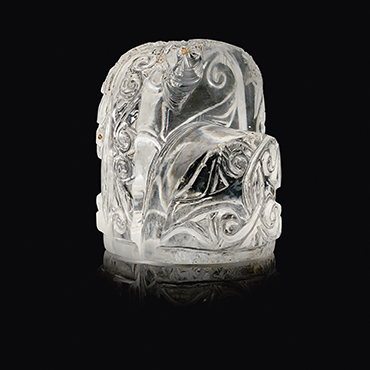A king crafted for a court
This large chess piece representing a king is carved from a single block of rock crystal. The game of chess originated in India under the Gupta dynasty and spread to Sasanian Iran and then to the Islamic world where Arabic treatises on chess are known since the 9th century. The Arabic term for the game is shatranj, from the Middle Persian chatrang. This is, in turn, from the Sanskrit chaturanga (literally “in four parts”), describing the four components of an early Indian army: infantry, cavalry, elephants, and chariots.
During the early Islamic period, chess-pieces became increasingly abstract in shape and decoration. Earlier examples of the king show him riding an elephant or seated on an elaborate throne. By the Fatimid period (AH 358–566/969–1171 CE), the double arched shape of this rock crystal became the accepted way of depicting the king piece. The shape may derive from the head, torso, and projecting knees of an enthroned king or the head and torso of a king behind the large head of his elephant mount.
The use of luxury materials, such as rock crystal and ivory, reflect the popularity of chess amongst the elite members of Fatimid society. Rock crystal was an exotic import, largely from Madagascar, and was delicately worked by court craftsmen in Fatimid Cairo. Although al-Hakim, the Fatimid ruler of Egypt, is said to have banned chess in AH 395/1005 CE and ordered all chess sets burned, his instructions were not universally followed and there are many surviving examples of Fatimid chess pieces. When the Fatimid treasury was ransacked later in the 5th century AH/11th century CE, it was noted to contain chess pieces made of gemstones, precious metals, ivory, and ebony, as well as textile gaming boards embroidered with gold thread.
Chess piece
Cairo, Egypt, AH 364–441/975–1050 CE
Rock crystal, h. 5.8 × w. 5 cm
The Al Thani Collection, ATC936

